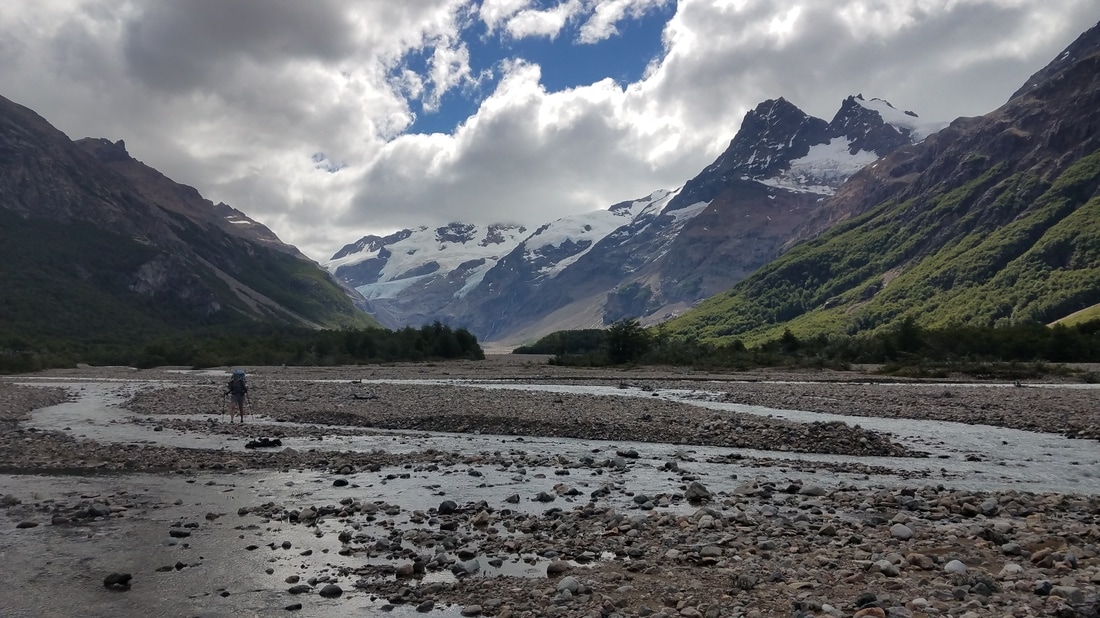By: Dylan Jones, Part 1 of 2
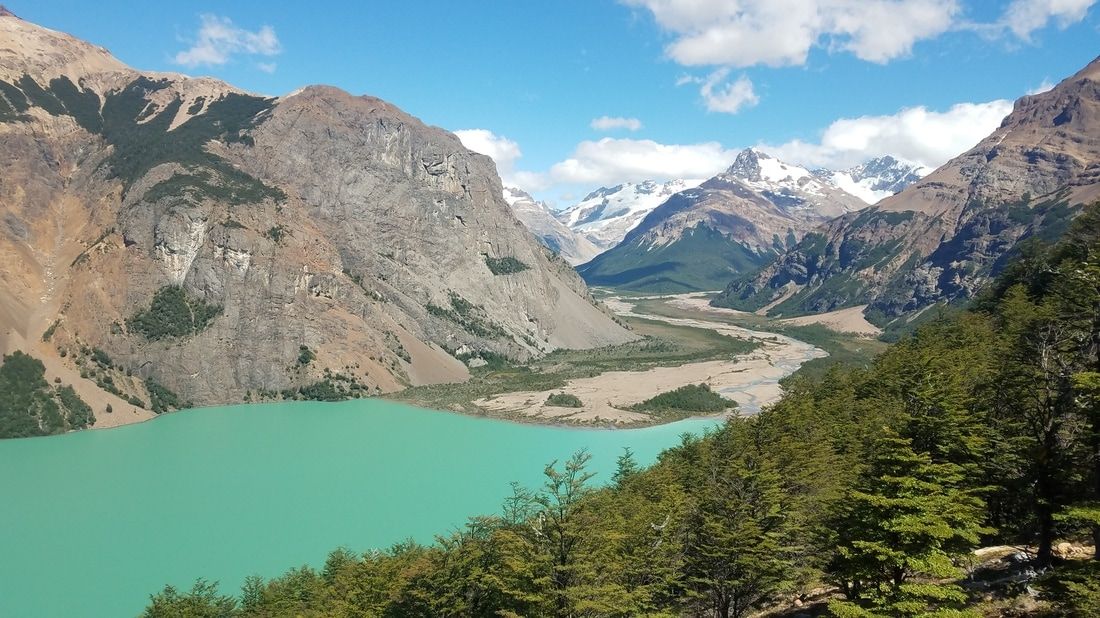
Valle Hermoso’s glacial waters drain into Lago Verde. The water in the braided streams is laden with rock flour sediment, making it too difficult to analyze for microplastics in the lab. PC: Dylan Jones
I feel as if we’ve stumbled into the center of the universe. We emerge from the thick forest canopy that had been obscuring our view for miles. The landscape is vast. Milky water from a braided stream weaves across a wide riverbed comprised of cobbles in shades of red, green, and purple. Majestic spires crown craggy peaks as waterfalls tumble thousands of feet from snow fields in shaded couloirs. The sky is even bigger. It appears we’re just a handful of miles from the large glacier to the north, but perceived distance in the alpine is often skewed.
Parque Patagonia
We’ve finally reached Valle Hermoso, one of the more pristine places in northern Patagonia. I’m surrounded by good company, traveling with expedition photographer Gabe DeWitt, writer Samantha Larson, and guide Nadine Lehner to document Parque Patagonia, a 200,000-acre tract currently owned by eco-philathropist Conservacion Patagonica that will join Chile’s Jeinimeni and Tamango national reserves to form the future 640,000-acre Patagonia National Park.
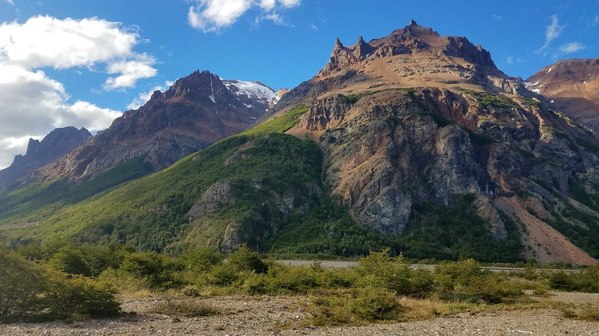
Craggy spires adorn the mountains of Valle Hermoso in Chile’s Jeinimeni National Reserve, which will join Parque Patagonia to form the 640,000-acre future Patagonia National Park. PC: Dylan Jones
It’s day two of our three-day trek of Sendero Avilés, a 31-mile point-to-point hike that connects Parque Patagonia to the Jeinimeni National Reserve. It’s a hike that Lehner, former executive director of Conservacion Patagonica and owner of Chulengo Expeditions, says “will probably become the classic backpacking trip of the park.”
Although we’re here to document the park, I’m on a personal mission to gather water samples for the Adventure Scientists Global Microplastics Initiative, an ambitious project seeking to identify sources, composition, and distribution of microplastics pollution in freshwater.
Final Frontier
Nadine informed us that this remote part of the Aysén Region, Chile’s least populous, was one of the final places in South America to be settled. I think about that as a brilliant shaft of sunlight pierces the evening clouds and illuminates the stream at the terminus of Valle Hermoso’s glacier. I scoop the ice-cold water in my hands and take a drink. Little human and animal activity means the Giardia lamblia parasite is currently nonexistent, turning most streams and lakes into potable water sources.
It suddenly strikes me that we are in one of the final frontiers on the planet. According to Nadine, since the area was settled by sheep ranchers in the early 1900s only a few thousand people have set foot in this valley.
It also strikes me that this should be the site of my first water sample. I fill my plastic bottle and can’t see through it. The water in this stream is quite opaque from rock flour—pulverized stone particles suspended in solution that give glacial runoff its unmistakable hue.
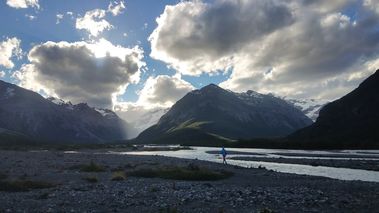
Samantha Larson heads off to explore Valle Hermoso as a sunbeam bathes the head of the valley in evening light. PC: Dylan Jones
|
Although spectacular in beauty, I decide this sampling site is not ideal for the analytical requirements of the Global Microplastics Initiative—too much sediment can make analysis impossible under strict lab protocols. Nadine tells me that tomorrow, we’ll ascend a pass and drop into the next valley where a crystal-clear stream should offer prime sampling conditions. I reluctantly stuff the bottle back into my pack. |
Finding Clarity
We stomp through the ephemeral braids of the stream under the morning sky. By now, we’ve accepted wet boots as the norm on Sendero Avilés, and I get a childish sense of joy with each splash into the ice-cold water. After a few miles, we reach Lago Verde—a massive, Gatorade-colored lake that collects the melt water of the surrounding glaciers. Gabe braves numb legs and shoots in the middle of the stream as our team makes the final crossing before the pass.
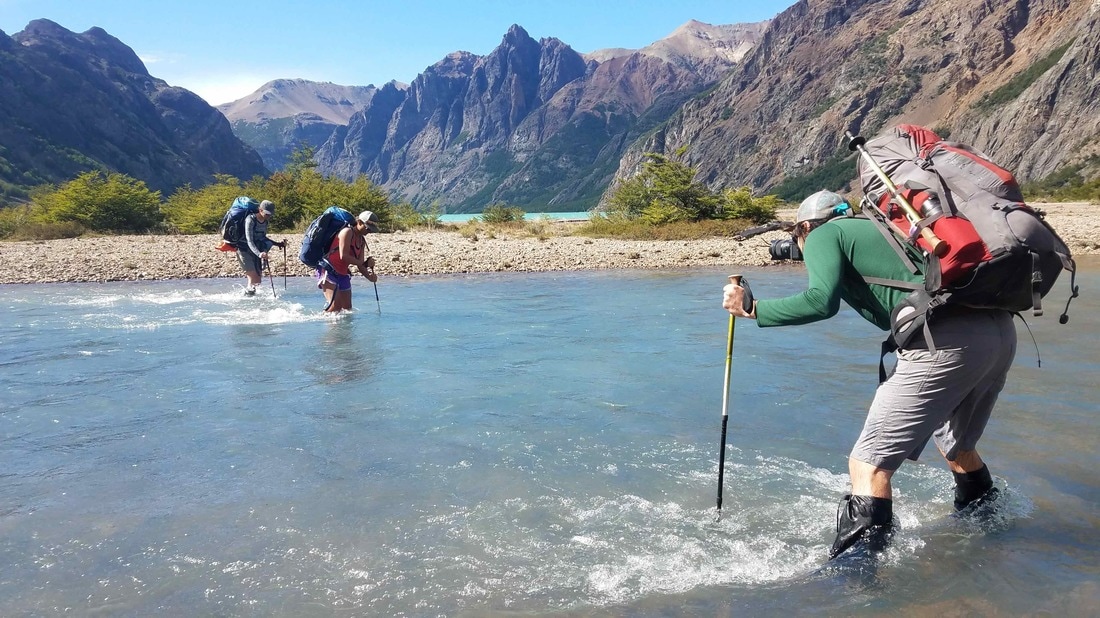
Expedition photographer Gabe DeWitt embraces numb feet to shoot as guide Nadine Lehner (right) and writer Samantha Larson (left) cross the braided streams near Lago Verde. PC: Dylan Jones
Near the saddle of the pass, Samantha and I stop to catch our breath and take in the grand finale view of Valle Hermoso. Although we’ve been to some incredible places in our respective travels, we’re both rendered speechless by the beauty before us.
The riverbed of the neighboring valley appears to be older. Crystal-clear water flows in calm riffles through the gravel bars in a single channel, just as Nadine promised. I dig the plastic bottle out of my pack, and Gabe films as I take my first sample in South America. Euphoria accompanies my wide smile as I record the data on my smartphone. Although I’ve added over two pounds of weight to my pack, it’s an even trade for the weight that suddenly lifts from my mind.

Gabe DeWitt films as the author collects a water sample from an unnamed valley in northern Patagonia. This was his first sample in South America. PC: Samantha Larson
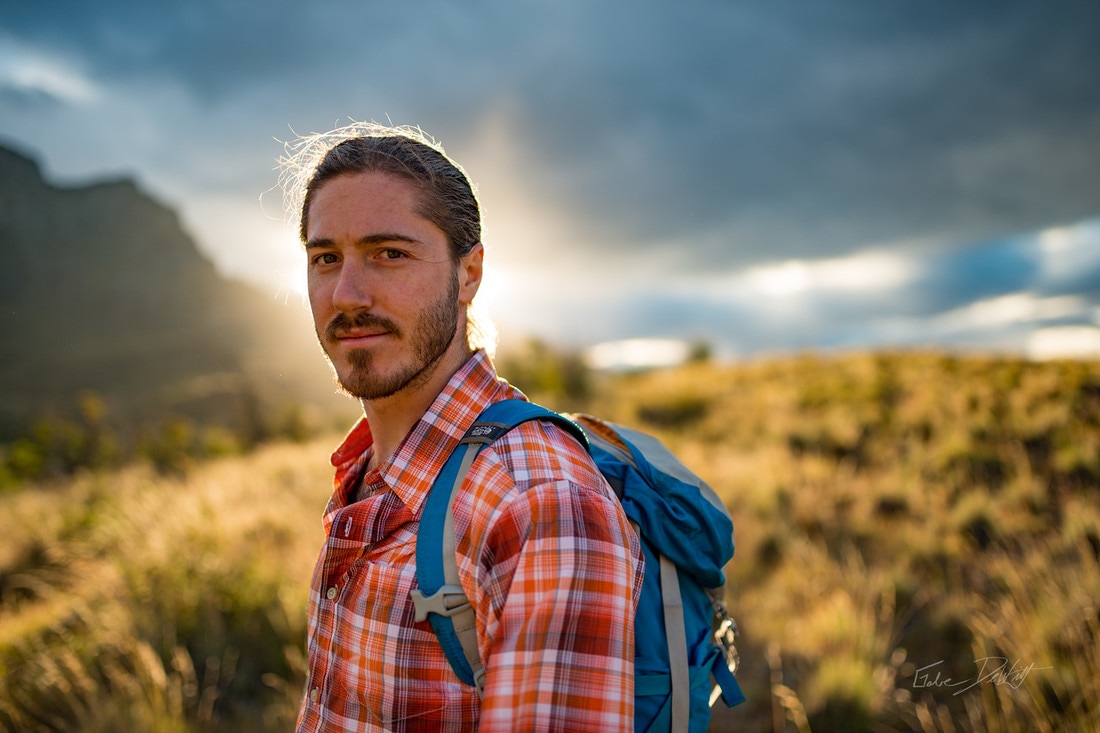
PC: Gabe DeWitt
|
Dylan Jones is a writer and photographer based in the mountains of West Virginia. He has collected data for Adventure Scientists in the American West, Thailand, Costa Rica, and Chile. He is managing editor of Highland Outdoors and a regular contributor to RootsRated. Dylan holds a bachelor’s degree in journalism and a master’s degree in public administration, both from West Virginia University.
|



